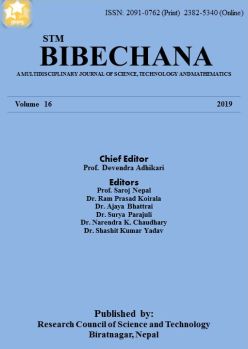Investigation of the firing temperature effects on clay brick sample; Part-I: Mineralogical phase characterization
DOI:
https://doi.org/10.3126/bibechana.v16i0.21319Keywords:
Brick, Firing temperature, Phase composition, Clay minerals, XRD, FTIRAbstract
Present research work was focused to investigate the firing temperature effects on mineralogical phase composition of nine clay bricks collected from the brick factory of Kathmandu valley using X-ray diffraction (XRD) patterns and Fourier transform infrared (FTIR) spectra analyses. Main mineralogical phases of quartz, feldspars, spinel, mullite and hematite in the brick specimens fired at different firing temperatures including muscovite type of mica mineral in the sun-dried brick specimen are identified from XRD and FTIR analyses. Disappearance of the muscovite type of mica clay mineral with feldspars enhanced to form alumina rich spinel phase at firing 900° to 1000° C, and finally the primary mullite phase in the fired clay brick samples is clearly observed at 1100° C firing temperature.
BIBECHANA 16 (2019) 122-130
Downloads
Downloads
Published
How to Cite
Issue
Section
License
This license enables reusers to distribute, remix, adapt, and build upon the material in any medium or format for noncommercial purposes only, and only so long as attribution is given to the creator.




